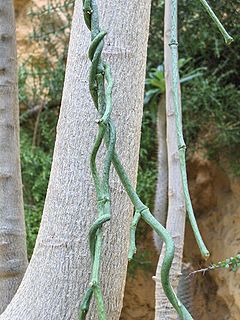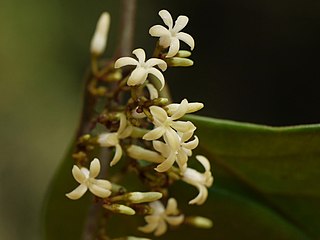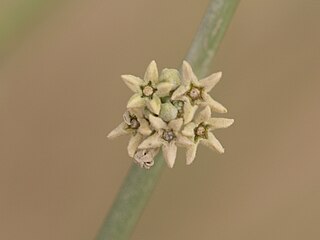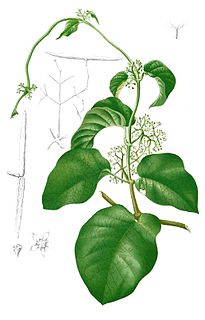
Apocynaceae is a family of flowering plants that includes trees, shrubs, herbs, stem succulents, and vines, commonly known as the dogbane family, because some taxa were used as dog poison. Members of the family are native to the European, Asian, African, Australian, and American tropics or subtropics, with some temperate members. The former family Asclepiadaceae is considered a subfamily of Apocynaceae and contains 348 genera. A list of Apocynaceae genera may be found here.

Cynanchum is a genus of about 300 species including some swallowworts, belonging to the family Apocynaceae. The taxon name comes from Greek kynos and anchein, hence the common name for several species is dog-strangling vine. Most species are non-succulent climbers or twiners. There is some evidence of toxicity.

Sarcostemma is a genus of flowering plants in the dogbane family, Apocynaceae, first described as a genus in 1810. The name is derived from the Greek words σαρκὸς (sarkos), meaning "flesh," and στέμμα (stemma), meaning "garland". Members of the genus are known generally as climbing milkweeds or caustic bushes. They are found across Africa and tropical Asia, in Australia, and in parts of North America. These plants are perennial flowering shrubs with trailing vines or lianas. They are often adapted to heat and/or desert conditions. Some have few or no leaves and photosynthesize in the tissues of the green stems. The soft stems are filled with a milky white latex that is poisonous and caustic in some species. The flowers have a ring of thick tissue at the base which extends into hollow spherical appendages within the flower corolla.

Rauvolfioideae is a subfamily of the flowering plant family Apocynaceae. Many species are woody lianas, others are shrubs or perennial herbs.

Periplocoideae is a subfamily of the dogbane plant family, Apocynaceae. It was not divided into tribes as of 2014.
Gongronema is a genus of plants first described as a genus in 1844. Some of the species are native to Africa, with others in South and Southeast Asia.

Orthosia is a genus of plants in the family Apocynaceae, first described as a genus in 1844.

Toxocarpus is a genus of plants in the family Apocynaceae. It is native to China, the Himalayas, and Southeast Asia.
Nephradenia is a genus of plants in the family Apocynaceae, first described as a genus in 1844. They are native to South America.

Heterostemma is a genus of plants in the family Apocynaceae, first described in 1834. It is native to India, China, Southeast Asia, Australia, and certain islands in the Pacific.

Leptadenia is a genus of plants in the family Apocynaceae, first described as a genus in 1810. It is native to Africa, including Madagascar, as well as southwest Asia and the Indian Subcontinent.
- Leptadenia arborea(Forssk.) Schweinf. - Sudan, Ethiopia
- Leptadenia lancifolia(Schumach. & Thonn.) Decne. - tropical Africa
- Leptadenia madagascariensisDecne. - Madagascar
- Leptadenia pyrotechnica(Forssk.) Decne. - widespread from Algeria to India
- Leptadenia reticulata(Retz.) Wight & Arn. - Madagascar
Odontanthera is a genus of plants in the family Apocynaceae first described as a genus in 1883. It contains only one recognized species, Odontanthera radians, a rare plant native to the shores of the Red Sea.

Orthanthera is a genus of plants in the family Apocynaceae, first described as a genus in 1834. It is native to India and Africa.
- Orthanthera albidaSchinz - Namibia
- Orthanthera butayei(De Wild.) Werderm. - Zaire
- Orthanthera gossweileriC.Norman - Angola
- Orthanthera jasminiflora(Decne.) N.E.Br. ex Schinz - South Africa
- Orthanthera strictaHiern - Angola
- Orthanthera vimineaWight - Uttar Pradesh in India
Pentatropis is a genus of plants in the family Apocynaceae, first described as a genus in 1834. It is native to Africa and southern Asia.
Pentopetia is a plant genus in the family Apocynaceae, first described as a genus in 1844.

Rhyssostelma is a species of plants in the family Apocynaceae first described as a genus in 1844. It contains only one known species, Rhyssostelma nigricans, endemic to Argentina.

Streptocaulon is a genus of plants in the family Apocynaceae, first described as a genus in 1834. It is native to India, China and Southeast Asia.
Hemipogon is a genus of flowering plants in the family Apocynaceae, first described as a genus in 1844. It is native to South America.
Gymnema elegans is a species of plants in the family Apocynaceae. It is found in Tamil Nadu.
Vincetoxicum lineare is an edible species of plant found in arid regions of Australia, it is also known as the bush bean. The habit of the slender plant is a climber or trailer, with stems obtaining a length around two metres. The flowers appear throughout the year, except during February to March, the purple brown colour beginning as a greenish yellow. The margin of the corolla is often hairy, the lobes are deeply divided. Three to seven umbels appear in an axial arrangement, from which a twenty centimetre pod is produced.












